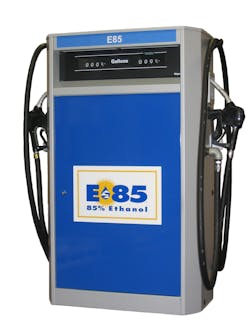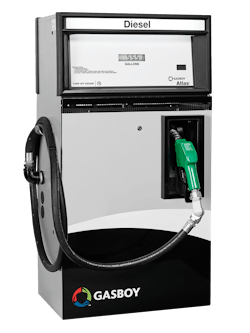Hardware Report: Fuel dispensers
If some or all of your fleet’s fueling needs are being met on-site at company facilities, it’s likely you’ve had to specify fuel dispensing systems. “Fleets should work with a manufacturer that offers a wide range of dispensers with features and options designed specifically to meet their unique needs,” says Kevin DeVinney, director of dispensers and fleet systems at Gilbarco Veeder-Root. “For example, many fleets have a variety of vehicle sizes, which can lead to the need for high-flow, super-high-flow, and ultra-high-flow rate models. Satellite dispensers should also be considered to allow simultaneous fueling of saddle tanks.”
When evaluating fuel dispensers, fleets should consider fuel compatibility, suction pump or remote dispenser configuration, flow rate, nozzle and hose orientation, mechanical or electronic registration, and interfaces to fuel control systems, says Kent Robinson, product manager of fleet products at Wayne Fueling Systems. “Although standard dispensers are compatible with gasoline and diesel products, E85 and diesel exhaust fluid (DEF) require special fluid-handling components because of their corrosive properties,” he adds.
Gasboy commercial fueling pumps and dispensers include the Atlas product line. All Atlas models have options for front- or side-loaded nozzles and are compatible with Gasboy Fleet Management Systems to help track and manage fuel use. “When choosing a fueling system,” Gilbarco’s DeVinney explains, “it’s important to think ahead to upgrades and to be consistent with equipment layout, future fuel capability, and wiring needs.”
The Wayne Select dispenser product line is offered in various flow rates, including models up to 60 gpm. Superhigh and ultra-high-capacity models are offered in master and satellite models with master and satellite hoses for fueling vehicles with saddle tanks. All Select dispensers have single- and dual-hose models; side- and lane-facing nozzle configurations are available. Select fleet fuel dispensers with fuel control systems integrated directly into the dispenser to simplify installation are also offered. With this system, each dispenser terminal has an IP address and a PC-based controller so it can communicate across an existing local area network.
Ward provides fuel management solutions for site wide control and automated fuel access for fleets of any size. The company’s W4 fuel control terminal is a stand-alone solution that interfaces with dispensing systems for any fuel type.
Bennett 3000 Series commercial fleet fueling systems are available in high- or low-frame models with up to two hoses per side. Standard flow rate models are from 15-24 gpm, and models with flow rates of up to 60 gpm are available for high speed diesel truck fueling. The company also offers the Bennett 100 and 200 BlueFueler Series DEF dispensers designed for use with barrels, totes, and aboveground and underground storage systems.
Benecor manufactures DEF dispensing and storage systems designed to fit on a standard fleet fueling island. According to the company, the plug and pump setup has a DEF nozzle, a 25-ft. hose, and a pre-wired and pre-piped enclosure. A cold weather package is optional.
The QuikQ Fuel Purchase System manages fuel transactions through real-time direct carrier to truck stop connectivity. QuikQ’s RFID-based fueling system is currently being installed at truck stops nationwide and is being adopted by a growing number of motor carriers.
Fleets have numerous choices in fuel dispensing systems. According to suppliers, however, they should keep in mind that the dispensers are often kept in service for a long time, and they should also consider the availability of service and replacement parts.

